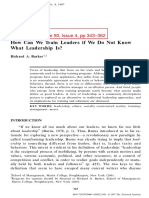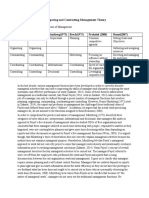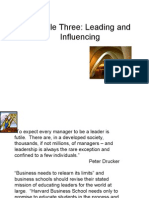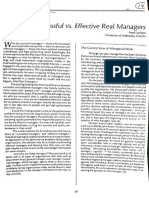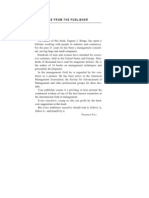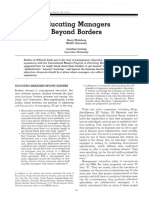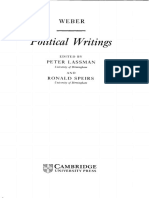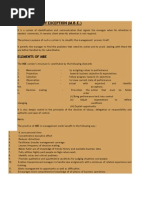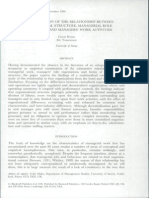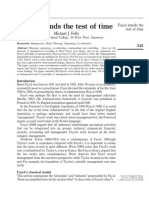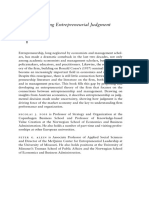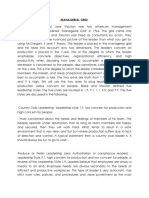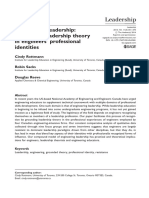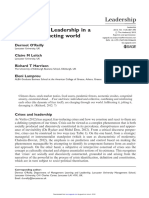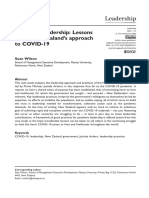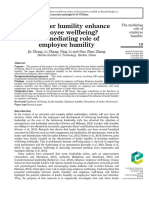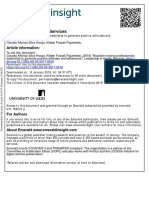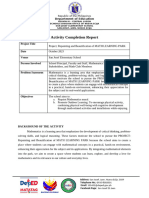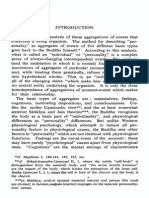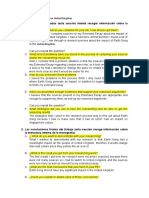The Bumpy Road To Exercising Leadership: Fragmentations in Meaning and Practice
The Bumpy Road To Exercising Leadership: Fragmentations in Meaning and Practice
Uploaded by
Ovidiu BocCopyright:
Available Formats
The Bumpy Road To Exercising Leadership: Fragmentations in Meaning and Practice
The Bumpy Road To Exercising Leadership: Fragmentations in Meaning and Practice
Uploaded by
Ovidiu BocOriginal Title
Copyright
Available Formats
Share this document
Did you find this document useful?
Is this content inappropriate?
Copyright:
Available Formats
The Bumpy Road To Exercising Leadership: Fragmentations in Meaning and Practice
The Bumpy Road To Exercising Leadership: Fragmentations in Meaning and Practice
Uploaded by
Ovidiu BocCopyright:
Available Formats
Article
Leadership
The bumpy road to exercising 0(0) 1–18
! The Author(s) 2016
leadership: Fragmentations Reprints and permissions:
sagepub.co.uk/journalsPermissions.nav
DOI: 10.1177/1742715016644671
in meaning and practice lea.sagepub.com
Mats Alvesson and Anna Jonsson
Lund University, Sweden
Abstract
The present study focuses on a manager’s understanding of leadership and how this guides – or
does not guide practice. The paper reports an empirical in-depth study of a middle manager in an
international manufacturing company. We link our discussion to both – the mainstream leadership
studies, which assume that managers have a solid type of leadership behavior, and authors with a
meaning-oriented, linguistic approach to leadership, in which language, self-awareness, and behav-
ior are linked. The present study suggests that leadership attempts can vary, be divisive, and that a
manager’s advocacy efforts are driven by a multitude of different, partly opposing, forces, meaning
a decoupling of ideas and behavior in leadership practice. The paper raises the question of
whether managers’ meanings of leadership correspond with what they do in practice.
Keywords
Identity, managing, qualitative research, relational leadership, practice
Introduction
Leadership is not easy – neither in practice nor in theory. Despite, or perhaps rather because
of, the countless studies, research on leadership is fragmented and results are often contra-
dictory (for overviews, see e.g. Antonakis et al., 2004; Bolden et al., 2011; Bryman et al.,
2011; House and Aditya, 1997; Hunt, 2004; Parry and Bryman, 2006). As Collinson (2014)
reminds us; James M. Burns noted already in 1978 that even though leadership is one of the
most observed phenomena it is one of the least understood. Leadership can be almost any-
thing related to ‘‘influencing’’ but is often seen as a matter of position, personality/traits, and
behavioral types or styles.
Corresponding author:
Mats Alvesson, Department of Business Administration, School of Economics and Management, Lund University,
P.O. Box 7080, SE-220 07 Lund, Sweden.
Email: mats.alvesson@fek.lu.se
Downloaded from lea.sagepub.com at UNSW Library on April 19, 2016
2 Leadership 0(0)
Current popular distinctions include transactional and transformational leadership,
democratic versus authoritarian, task-oriented versus person-centered, and authentic
versus unauthentic. Others set up heroic, monologic leaders versus relational, dialogic
ones (cf. Cunliffe and Eriksen, 2011). Commonly across all these streams and labels is the
often taken for granted assumption that there are stable, cohesive, and unambiguous forms
of leadership that correspond to certain categories or ideologies (Alvesson and Kärreman,
2016). It is typically assumed that managers or others doing leadership have a particular
disposition – personality, ideals, values, competencies, interests – and that this guides them
in practice in a coherent, integrated way. There is interest in leader personalities or styles that
are supposed to offer a base or platform, which is then expressed in a fairly coherent action.
Such research tends to take for granted that there is an essence or a cohesive style, and which
forms the basis of the leadership, for example:
[. . .] leadership can be defined as the nature of the influencing process – and its resultant out-
comes – that occurs between a leader and followers and how this influencing process is explained
by the leader’s dispositional characteristics and behaviors, follower perceptions and attributions
of the leader.. . . (Antonakis et al., 2004: 5)
Both assumptions expressed in this citation – that there are essential, fixed qualities, and that
these directly guide actions – can be questioned. Dominant research on leadership rarely
questions this. However, it is not clear that ideas of a straightforward leadership process
contribute to our understanding of how leadership relations actually manifest themselves, or
develop, in complex organizational contexts (Crevani et al., 2010; Fairhurst and Uhl-Bien,
2012; Holmberg and Tyrstrup, 2010; Lundholm, 2011). Closer study of the narratives of
managers trying to describe their ‘‘leadership’’ indicates that they often are ambiguous and
confused (Alvesson and Sveningsson, 2003; Carroll and Levy, 2008; Sveningsson and
Larsson, 2006). Studies of narratives may say less about practice – incoherent leadership
talk accompanied by coherence and direction in practice is in fact a possibility. At least one
cannot determine a straightforward relationship between talk and practice.
In order to develop our understanding of leadership (or perhaps ‘‘leadership’’), we need
more in-depth studies of individual cases where questions such as the possible (in-)consist-
ency in behavior and the possible influence are studied in practice. There is a shortage of
studies of leadership practice. The relationship between the espoused leadership views of
managers and what they do in daily work has not been particularly well researched. Larsson
and Lundholm (2010: 160) stress that leadership seems to be missing in practice as ‘‘man-
agers fill their days with meetings, budget work, emailing and other typical managerial
tasks.’’ Alvesson and Sveningsson (2003) describe a similar view and a reality where man-
agers are trapped in operational work that prevents them from their preferred, somewhat
grandiose, leadership.
However, our interest in practice does not mean that we take what is currently sometimes
termed ‘‘a practice perspective’’ and view leadership as a group practice about collabor-
ations. Raelin (2011: 196), for example, claim that ‘‘leadership-as-practice is less about what
one person thinks or does and more about what people may accomplish together. It is thus
concerned with how leadership emerges and unfolds through coping in day-to-day experi-
ences.’’ Raelin (2011) suggests that we ‘‘find leadership’’ when observing practice – referring
to where it is occurring. We agree, but also note that a lot of the things people ‘‘accomplish
together’’ can be understood in terms other than leadership (Alvesson et al., 2016). In this
paper, we focus on how a middle manager tries to do leadership – thus to influence the
Downloaded from lea.sagepub.com at UNSW Library on April 19, 2016
Alvesson and Jonsson 3
meanings and directions of others. So, rather than following practice ideas on collaborative
work we are, in this paper, more focused on managerial behavior and interactions in terms of
leadership in specific situations. Leadership is then, in this context, viewed as the efforts to
influence others within an asymmetrical relation, mainly through meanings, cognitions, and
ideas, not through administration or instructions for specific behaviors. We do have sym-
pathy for the proposal that there is a need for more research on the processes, practices, and
interactions and disregard individual leaders (Crevani et al., 2010), but this does not counter
the importance of close-up studies of what managers do when they try to do what they claim
as (and by dominant views on the subject matter is seen as) leadership.
A key question for understanding leadership concerns whether this is being guided by a
clear idea, ideology, or inspiration creating coherence and direction or if it is characterized
by variations, inconsistencies, ambiguities, and fragmentations of meanings and practices of
leadership. This is a fundamental issue regularly bypassed in research; questionnaire-based
studies are typically based on the idea that a clear pattern can be drawn from regularities in
the leader’s behavior. Pattern-seeking studies tend to find – yes, patterns, an underlying
meaning behind inconsistent talk (Alvesson, 2011a; Potter and Wetherell, 1987).
Qualitative leadership studies also often assume coherence between talk, meanings, and
practices (Cunliffe and Eriksen, 2011; Kelly, 2008), while interview-based studies aim to
find a coherent understanding or sets of meanings. But we can’t take it for granted that
talk, meaning, and practice are integrated and consistent.
Our interest is more in the open investigation of the relations between leadership ideas
and what managers do in specific settings. This calls for in-depth research including inter-
views and observations. In general, there is a shortage of ambitious case studies of typical
managers, in which context, content, and behavior are taken seriously. Much research is
about the ‘‘leader’’ or ‘‘follower’’ being forced to answer prefabricated questions in which
assumptions of patterns in leadership are more or less built into the design (Hunter et al.,
2007). Leadership is often over-packaged into obvious categories, both in practice and in the
literature. In this study, we seek to present a more realistic picture of the efforts of managers
to exercise and do leadership. Our study concurs with in-depth studies, which problematize
the usefulness of the concept of leadership, at least in the more typical contexts in which the
majority of managers operate and where the opportunities to exercise a clear form of lead-
ership may often be limited (Alvesson et al., 2016; Holmberg and Tyrstrup, 2010;
Sveningsson and Larsson, 2006). We take interactions and relations seriously, but see lead-
ership as based on an asymmetrical (authoritative) relationship, and in this paper we follow a
manager possibly doing/trying to do leadership in relationship to ideas, inspirations, and
other input to leadership. Following this, the aim is to contribute to our understanding of the
possible coherence, or incoherence, of a manager’s meaning(s) of leadership in relationship
to practice, where the complexity in the organizational environment is taken into account.
One important question in the context of leadership is whether leadership can be said to
exist as a cohesive and consistent direction of attempts to influence others (through a set of
ideas, a certain style, or leadership type). Another important question is where any such
direction comes from; does it emanate from within the manager themself – which would
appear to be a dominant assumption, or from the circumstances of the situation, such as the
coworkers’ characteristics (Yukl, 2011), or is it guided by the prevailing organizational cul-
ture or norms (Alvesson, 2011b)? We lean toward both ‘‘the primary train of thought’’ of
studies of leadership, which take as their starting point that managers have a stable ‘‘form’’
of leadership behavior (task oriented, relation oriented, intellectually stimulating,
Downloaded from lea.sagepub.com at UNSW Library on April 19, 2016
4 Leadership 0(0)
participatory, transformational, etc.) and to ‘‘meaning’’ authors who maintain that man-
agers/leaders have a ‘‘home-grown’’ view of leadership, in which use of language, self-aware-
ness, and behavior are closely linked (Fairhurst, 2009; Kelly, 2008; Rottmann et al., 2015).
Both parties share the assumptions about a high degree of coherence and direction in mean-
ing and behavior. But this can be opened up for investigation: The questions we ask our-
selves are: 1.) Is there a clear base or platform for leadership, in the form of the leader’s
personality, outlook and values, or a work/organizational context that provides norms for
leadership? Do managers have, for example, an integrated self-awareness or a clear idea of
key ideas and meanings for leadership practice? And; 2.) Does leadership have a clear dir-
ection; in other words, does it express a relatively cohesive practice? Are there, for example,
regularities and consistencies in the influence process of a manager doing leadership? Or is
the leadership effort fragmented, uncohesive, and on an ad hoc basis? These are quite fun-
damental questions and if the answer at least sometimes are ‘‘no’’ or even ‘perhaps not,’ they
indicate a strong need to rethink leadership, often based on assumptions of a clear base and
a clear direction, and summarized in popular expressions signaling integration and coher-
ence (such as all the popular leadership types and categories – from task oriented and
transformational to relational and authentic). Metaphorically speaking, our aim is to illus-
trate leadership efforts in terms of a compass and to follow, or trace, that compass; is there a
compass for the approach to leadership? If so, is it followed; or in other words, can the
direction be maintained? In more simple terms, does the manager who is supposed to, and
claiming to, do leadership have a clear idea/framework for this? If so, is s/he adhering to that
idea/framework?
A study of a manager doing ‘‘leadership’’
Despite the enormous amount of research on leadership the question of whether leadership
has in fact been seriously studied is relevant to ask, at least if one takes qualities like the
influence process and practice seriously. Barley and Kunda (2001: 90) warn us of the oppos-
ite when they write that models and theories which do not build on studies of ‘‘what people
actually do’’ can be misleading: ‘‘The dearth of data on what people actually do – the skills,
knowledge, and practice that comprise their routine work – leaves us with increasingly
anachronistic theories and outdated images of work and how it is organized.’’ In fact, this
is very much the case with leadership; many texts score high on ideology and low on intel-
lectual precision (Alvesson and Kärreman, 2016).
If we are to increase the understanding of the phenomena being studied, it is essential that
the researcher is open to local meanings of leadership, and not only aims to discover patterns
or ideologies, but is also sensitive to inconsistencies and fragmentations as well as the pos-
sibility that ‘‘leadership’’ may not always be a fruitful way to understand managers and
others at work. Empirically, richer understanding often calls for observations in combin-
ation with interviews. In order to avoid relying on a snapshot understanding provided by a
single interview or observation, it is vital to check for consistency and variation between
interviews and observations.
This study, which focuses on Kim Mix as a manager and possible leader, is therefore both
based on interviews and reflective conversations (10) and on observations of meetings (8).
For a total of three weeks, we had the opportunity to ‘‘shadow’’ manager Kim Mix in their
daily work – a method used for gathering empirical data about what a person does, indi-
vidually and collectively with others in an organization, in daily work (Gherardi, 2006).
Downloaded from lea.sagepub.com at UNSW Library on April 19, 2016
Alvesson and Jonsson 5
Some of the interviews were of a more reflective nature, where Kim before and/or after a
meeting considered the purpose of the meeting or the outcome of the meeting. Our obser-
vations thus focused on planned meetings, which can be seen as a major arena for leadership
(Lehtinen and Pälli, 2011: 287). An interesting observation per see is that it was often Kim
who took the initiative to reflect after a meeting. Whether this was a result of will to support
our understanding of leadership, a general interest in the topic or a feeling of being insecure
about leadership is however hard to tell (cf. Collinson, 2014).
The context for the study is a large, international manufacturing company (RR) where
Kim, a middle manager, works as both a line manager and integration manager, and is also a
member of the extended management team. This multiple role job is important to consider –
it is quite common that managers do not just have a fixed relationship to a group of sub-
ordinates but have rather different types of relationships that need to be considered,
although seldom acknowledged by the dominant leadership research that rather tends to
divide the world in leaders and followers within fixed units. The company has previously
been very successful and many employees, mostly engineers, have been working at the com-
pany for a long time. The fact that the company mostly consists of engineers is further
interesting to note as previous research has indicated a certain resistance toward dominant
leadership paradigms among engineers and that the professional identity of being an engin-
eer guides the ‘‘engineering leadership’’ (Rottmann et al., 2015).
Case study: Research design and data analysis
Our case study thus builds on interviews, reflections, and observations. The interviews lasted
between 90 and 120 min and can best be described as conversations with an open interview
structure. Interview questions addressed Kim’s self-image, views on leadership, organiza-
tional context, and whether the company provided a certain platform for leadership, but also
work situation and relations to seniors, peers, and subordinates. The context is important for
our study following the focus on the situated nature of leadership and our interest in mean-
ings of leadership (cf. Bresnen et al., 2015). Many conversations took the form of reflective
talks, where Kim expressed views of specific interactions just having been observed; some
interviews can thus be described as relating to Kim’s practice. Focus for the observations
was on situations where Kim tried to influence subordinates – most of these attempts related
to administrative issues, information sharing activities but also decision-making but without
directly involving the influencing of subordinates.
All interviews and all observed meetings were recorded and transcribed. The data were
structured into four themes: organizational framework (support/requirements) for leadership,
personal views on theoretical inspiration (from readings and courses), Kim’s self-image of
being a leader, and assessment of specific work situation(s). These themes mainly emerged
from the interview material, but also stem from cross-checking the observation data, and
reflect the judgments of the researchers guided by previous research on leadership. The indi-
cators of a distinct organizational framework for leadership as well as Kim’s strong interest in
reading coaching literature made us consider these themes both in interviews and observa-
tions. In addition to interviews with Kim, we also interviewed one of Kim’s coworkers, for
additional insights on Kim’s leadership style (or lack thereof). This interview was used to
explore and serve us with ideas when we asked Kim to reflect on what leadership means in
practice. In particular, we were interested in Kim’s daily work and responsibility but also view
on leadership – to gain deeper understanding of explanations for possible inconsistencies in
Downloaded from lea.sagepub.com at UNSW Library on April 19, 2016
6 Leadership 0(0)
relation to talk, meaning, and practice. The few observed examples of leadership are high-
lighted and interpreted in relationship to Kim’s stated ideas and meanings on the leadership.
One problem inherent with detailed descriptions of meetings and other interactions is deter-
mining what can be called leadership, out of everything that takes place, and what should be
the focus of attention (Bryman et al., 2011). A fairly broad view where the manager tries to
influence the thinking or ways of thinking relating to tasks and self-understandings of sub-
ordinates – management of meaning – gives some direction. However, there was not much of
this in the observed interactions. The data analysis is guided by attempts to identify broader
themes and view them as part of episodes. All interview statements indicating Kim’s view and
meanings around leadership were analyzed in relation to the following themes: inspirations
for leadership (corporate policy, literature, and courses) as well as self-image and own inter-
pretation and thinking, as well as various constraints and contingencies. These themes were
then considered in terms of coherence and variation. Observations of Kim in various potential
leadership situations were interpreted in terms of their possible meanings and compared with
data from interview statements. Leadership behavior was then interpreted in terms of regula-
rities/patterns as well as variations and inconsistencies. However, it is important to note that
we believe that the idea of codification of qualitative data, as a method for how to secure
validity, just revealing the nature of data is misleading as emphasis often relates to finding
‘‘patterns’’; we are always to a large extent guided by frameworks, cultural ‘‘truths’’ and
preunderstanding, and need to consider context and do more ‘‘holistic’’ readings than
focus on fragmented pieces (Alvesson and Sköldberg, 2009).
Combined with an interest in leadership efforts we asked ourselves questions, when con-
ducting the analysis but also while doing the case study, such as ‘‘what is going on here’’ or
‘‘what does the daily work look like?.’’ Such questions counteract the uncritical reproduction
of dominant assumptions regarding, for example, the occurrence of, platform for, and direc-
tion of leadership. We organize the world through our choice of language, and in this we have
good reason to be wary (Foucault, 1980). Awareness of, and openness toward, different
perspectives and vocabularies is therefore essential (Alvesson and Sköldberg, 2009). This
may include skeptically considering the (dis-)advantages of leadership terminology. As a
step in this direction, we view the protagonist – and leadership thinking in general – with a
certain mild ironic distance (cf. Rorty, 1989). We hold, for example, the perception that the
protagonist could be described equally as a ‘‘meeting worker’’ and as a ‘‘leader.’’ This may
well be a better representation than the more (ideologically) charged ‘‘leader.’’ The purpose of
our ironic observation is not to be ironic toward Kim as a person, but toward the expectations
of what ‘‘leadership’’ is all about or what it is not about. Much of what is written about the
topic is pretentious and uncritical, and takes the phenomenon of ‘‘leadership’’ for granted and
as if there is consistency between talk, meaning, and practice. A certain critical distance is
therefore essential. An element of ‘‘defamiliarization’’ with what is (all too) well known and
taken for granted is included here. In the following section, we will describe and elaborate on
the patterns listed above. But first, we will present a brief description of Kim Mix.
The middle manager Kim Mix
Kim Mix is middle aged and has worked at RR for over 20 years, of which almost 15 years
as a manager. Kim attends a lot of meetings during our case study. During these meetings,
Kim asks many questions, rarely gives answers or suggestions, and schedules new meetings.
Downloaded from lea.sagepub.com at UNSW Library on April 19, 2016
Alvesson and Jonsson 7
Kim often expresses the view that it is fun to be observed and to be shadowed and wanted to
reflect on various meetings, which had been observed in silence. With reference to the initial
research questions, it is of interest to consider how Kim’s self-awareness regarding leadership
and participation in meetings corresponds to the practice where Kim works. We identify
three inputs to Kim’s view on leadership: organizational ideas, theoretical guidelines from
textbooks, and similar idea generators, and Kim’s self-image (personality, experiences).
These three sources of input not only significantly diverge but do so also in relation to
the leadership (attempts) in practice.
Organizational support/recipe for leadership
Important for the context is to acknowledge that a number of support measures for mana-
ging various ‘‘leadership challenges’’ had recently been developed in line with RR top man-
agement, stressing a ‘‘responsible industrial leadership.’’ One type of support for this is the
documented and prescribed company values: Freedom with accountability, partnership with
customers, suppliers and colleagues, long-term perspective, innovation, and commitment
and fun. However, Kim says that this is something top management works with but Kim
only ‘‘[keeps] the values in a file somewhere,’’ thus indicating that this is not something taken
seriously nor practiced. Another, perhaps more explicit support, is the documentation
regarding six ‘‘leadership challenges’’ and how RR expects its leaders to handle them. The
document (a power-point presentation) describes the challenges as a ‘‘behavioural philoso-
phy’’ and that part of the ‘‘‘leadership personality’ is to know thyself, then change thyself.’’
Two of these challenges are the principles of putting the ‘‘fish on the table’’ and to take the
‘‘bull by the horn’’ – emphasizing that difficult topics should not be avoided but that a leader
is expected to take responsibility also for questions that are uncomfortable. A third challenge
is to ‘‘choose the appropriate leadership style,’’ where it is stressed that an appropriate style
includes both strategy planning, dealing with crisis, and being able to balance between
‘‘coaching a ‘good’ employee and a ‘difficult’ one,’’ or ‘‘leading a diverse team vs. a homo-
genous one’’ as well as planning and executing change. Kim describes the support:
I know this is what the top management wants, but there are categories of middle management where you
can’t put the fish on the table without being questioned yourself, quite hard. That’s not really the point; the
point is that anyone should be able to bring up a problem, and to dare to do so. These expressions, even if
you don’t know them by heart . . . All the leaders at RR have heard this so many times.
Like this, for example, ‘This is a paradox’.
Yes, that’s exactly it. We’re supposed to be able to deal with it. And then ‘take the bull by the
horns’, meaning we’re not supposed to run and hide when things get difficult. We’re expected to be
ready to do battle.
The challenges are not described as ‘‘steps toward immediate success’’ or as being ‘‘easy.’’
The purpose of these challenges is to support the managers in their actual leadership –
perhaps acknowledging that leadership is not always easy in practice. ‘‘Communication’’
is the sixth challenge and it is acknowledged that ‘‘Leaders sell ideas, dreams and inspiration:
Communications is the most important instrument.’’ When asking whether they help or not,
Kim gives the following answer to the challenge with putting ‘‘the fish on the table’’: ‘‘The
point is that in a leadership context we are supposed to come back to it, not run to
Downloaded from lea.sagepub.com at UNSW Library on April 19, 2016
8 Leadership 0(0)
management and complain because this is the paradox; we have to understand that and deal
with it.’’ From this we understand that it is the subordinates and not the higher levels of
management that are to be exposed to the fish. It is their superiors who will use the fish. This
is actually addressed in the ‘‘closing thoughts’’ in the document with the six challenges with a
quote a former chairman of the Coca-Cola Company; ‘‘Leadership is one of the things you
cannot delegate. You either exercise it or you abdicate it.’’ How far it is possible for all
managers to exercise this leadership style appears to be an open question. As we will see,
Kim Mix sometimes refers to these challenges as organizational ideals for ‘‘leadership’’ in
practice.
Theoretical inspiration – The ideal of coaching leadership
Kim likes to be a coaching leader – although, not in any puristic way, as ‘‘sometimes you have
to be a manager.’’ Kim enjoys reading about leadership and especially coaching. Over the
years Kim has participated in a number of leadership and mentor programs, both encour-
aged by the company and on Kim’s own initiative. In the following extract from a conver-
sation with Kim, reflections are made of what is meant by leadership and if coaching is
different from being a leader:
Yes, I think leadership questions are interesting, so I try to read as much as possible [. . .]
Something that particularly interests me is this coaching element of leadership, I think that’s
really interesting. In the role I have towards one of my co-workers, I want him to use me as a
sounding board, but he shouldn’t get the answers from me. I want to ask questions to make him
think [. . .] and he should also feel he’s involved in our decisions, and I want him to work the same
way as a project leader in his organization. He shouldn’t give them the answers either, just move
things on in the same way. I particularly want him to take this on board in his coaching, because I
believe that it makes people grow. It develops people, and you feel a sense of responsibility for the
things you suggest. If I ask him questions, it makes him think, and then he gets enthusiastic too.
Then I say OK, we’ll do it [. . .] Sometimes we make mistakes but I don’t believe you can only follow
that leadership style. [. . .] When you read books about coaching and so on, they can be extreme, in
my opinion. Because they say that everything you do should be based on that, and I’m not there yet,
maybe I’ll get there some time. But I think a mix is preferable.
Kim strongly points at the ideal of coaching, finding that this ‘‘particularly interests me.’’
This indicates that this should be central although not ‘‘extreme,’’ in leadership efforts. Kim
also emphasized the importance of participation.
[. . .] what do you think distinguishes good leadership from bad?
A leadership style where you don’t listen to the organization, or to your people, when you think you
know best because you’re the manager. I don’t like that at all. . . . I think leadership needs to be
different in different situations. There are situations when the manager has to go in and says ‘No,
we’re doing it this way’. But for the most part, when you’ve got a little time, then it’s better that the
group or the organization comes up with the answer, because then they’ll commit.
Here, we get the impression of a clear and coherent view of ‘‘leadership.’’ Kim reads a lot of
coaching literature, finding this ‘‘really interesting.’’ The question is if it really influence thinking
or has mainly a seductive effect. Occasionally, there are reasons for exceptions and the need for a
mix, but Kim’s view appears to be strongly in favor of coaching and participation. Mostly it
should be the group or the organization – not the manager – that come up with the answer. If we
– as much leadership literature suggests – would be satisfied with this, there would be a
Downloaded from lea.sagepub.com at UNSW Library on April 19, 2016
Alvesson and Jonsson 9
confirmation of the assumption of there being a set of meanings and values, a coherent under-
standing guiding leadership. But as we will see, it is not so easy or straightforward.
Self-image
The company’s leadership ideal in addition to the coaching style that Kim favors is inter-
esting to compare with Kim’s self-image of leadership. Kim describes the role of being an
integration manager, and as member of the extended management team, as being more of
one of the team and says that ‘‘we’re all there on exactly the same terms.’’ At the same time,
Kim expresses a feeling of being powerful:
. . . sometimes they say, for example, that I have a lot of influence in my management group, and
maybe I should stand back a little and give other people more space. Because I still get my message
across, but maybe I shouldn’t always be in such a hurry.
So would you say you’re domineering?
I feel very confident about what I propose. . . . but maybe I shouldn’t speak so much.
Do you think it’s because you’re that kind of person, or is it something you’ve developed?
I don’t think it’s something that was shaped when I became a manager, I’ve always been like this.
We were five children in my family . . .. . .
The statement is about Kim’s person and family role but also relates to how Kim expresses
the relationship to colleagues in the management group, not to subordinates. At the same
time Kim emphasizes a different orientation and a radical change over the 15 years as a
manager in relationship to subordinates:
When I first became a leader I probably said ‘Right, this is the way we do things. No questions
asked’. I had my picture of how to do things. I don’t try to do that today, today you’re more likely to
make sure everyone has a chance to speak up. I think I give my co-workers a very free hand. They
come to me when there’s something they are not sure about.
Kim’s self-image is thus somewhat mixed and contradictory. Kim is, according to the interviews
and reflections after observed meetings, quite dominant but at the same time gives coworkers a
free hand. Kim has a fixed personality (‘‘always been like this’’) but has changed quite a lot as a
manager while doing leadership (‘‘very much into participation and helping people when they
are not sure about something’’). But the self-image of being in a hurry, having much influence
and speaking (too) much is not in line with coaching and participation ideals. Given this frag-
mented and inconsistent set of meanings and guidelines for leadership, the reader may ask what
is Kim doing then? How is leadership manifested in managerial practice?
Leadership (attempts) in practice
Ideals, principles, and recipes are fine, but in reality things are more complicated. It would
appear, from Kim’s description and reflections, that it is sometimes difficult to balance
leadership. Good leadership is not always good; sometimes what is, in principle, bad lead-
ership (generally disliked by Kim) may be necessary. Good leadership is perhaps best
described in terms of being aware and able to adjust to different situations and acknowledge
the fact of being trapped between different ideals represented both in theory and practice – as
Downloaded from lea.sagepub.com at UNSW Library on April 19, 2016
10 Leadership 0(0)
well as in personal traits. But the major idea seems to be about giving others much discretion
and do a lot of coaching.
How, then, do the company’s values and templates for leadership, Kim’s interest in
being a coaching leader and preference for participation, and self-image match? And what
if all this comes out in Kim’s role as a senior participant in meetings? It might be expected
that the coaching ideal or RR’s ‘‘fish’’ and ‘‘bull’’ principles of challenging leadership
would permeate much of the behavior. One problem is that putting the fish on the
table and taking the bull by the horns are effectively the antithesis of the coach (who is
mainly responsive to the issues brought up by the other and believing that people should
have discretion). In more recent times, the internal leadership training courses have aimed
‘‘to encourage uniformity, to develop a certain type of leadership at RR.’’ This goes in a
different direction than the coaching leadership that is Kim’s ideal, at least the espoused
one. Another problem, in terms of creating coherence for Kim, is that the coaching/par-
ticipation ideals are not altogether in line with Kim Mix’s personality and inclinations.
Kim is here somewhat contradictory: there is a claim of a movement from telling people to
‘‘give co-workers a very free hand.’’ There are thus leadership platforms – theoretical
inspiration, corporate expectations, various views of self, and ideology going in very dif-
ferent directions. In order to better understand what leadership involves, and what it
means in practice, we therefore need to understand what Kim does when interacting
with others, in particular subordinates (followers) – and not just how Kim talks about
it. Perhaps these diverse meanings and diverse platforms are followed by some clear dir-
ection in leadership practice?
Reprimanding – Rather than being supportive? In many meetings Kim is quite passive and is
participating in administrative work without much sign of ‘‘leadership,’’ although passivity
may be in line with ideals like ‘‘participative leadership’’ (leadership is often used as an
elastic term that almost anything can be included, but we see it as active influencing, pas-
sivity then not qualifying). Occasionally there are efforts to influence others broadly in line
with the ideas of leadership. One meeting that we observed is between Kim, as in the role of
being a line manager, and a person that is responsible for spare parts in another part of RR’s
organization. The purpose of the meeting is to agree on a price for an upgrade package. Kim
confronts the person with facts that they do not have but according to Kim should have.
According to Kim the person should have full command of the central question – the price –
and is upset about the fact that the person is unable to supply an answer within a reasonable
time.
This is absolutely crucial. It’s unbelievable. I mean, you must know which level you’re going to place
yourselves on? What are you talking about? We need to have an idea of what this is going to cost.
Surely you’re well-enough prepared to know what price you charge today?
This intervention may be read as reprimanding, but as is often the case when it comes to
‘‘leadership’’ (or perhaps rather supervision or exercise of power), can also be seen in other
terms, for instance, as educational or even supportive, although harshly expressed (but
leadership as management of meaning does not necessarily call for softness and there is
no reason to reserve ‘‘leadership’’ only for positive messages). There was very little evidence
of Kim’s espoused trademark – coaching – or claimed tendency to give coworkers, or col-
leagues, ‘‘a very free hand.’’ However, both the ‘‘fish’’ and ‘‘bull’’ made a clear appearance
during the meeting, so it is fair to say that at least the corporate principles for ‘‘responsible
Downloaded from lea.sagepub.com at UNSW Library on April 19, 2016
Alvesson and Jonsson 11
leadership’’ could been seen as practiced. Kim explains the situation afterward – perhaps
also the chosen ‘‘leadership style’’ – like this:
That’s a discussion that keeps coming up out at the market companies; that our customers think we
charge an unreasonably high price for certain spare parts. [. . .] So then you have to push them a
little more to make them understand that we need this now because people are asking for it. [. . .] as a
leader you’re expected to be able to handle the fish on the table and to manage paradoxes in these
types of situation, different interests are supposed to come together.
In another observation where Kim explicitly has claimed that it is important to play a supportive
role as a leader we noticed quite the opposite. Kim opens the meeting – even though it should
perhaps have been Neil, one of Kim’s subordinates, who called the meeting. Kim immediately
asks a lot of questions. During the meeting, Kim appears to act primarily as controlling and as
an information gatherer. It is not easy to see how Kim’s interventions express leadership in the
form of setting out a direction – either actual or in terms of values – or how they express support
for Neil. Invitations to participation and coaching are largely absent.
Governing – Rather than being a coach? In a discussion with a project leader, Robyn, responsible
for closing down the product that Kim as a line manager is responsible for, Kim starts by
stressing that the project leader has done a good job – thus supporting the project leader in
the work. ‘‘I must say, Robyn, I feel very comfortable having you in charge here. I think that
you are lifting every stone to see what’s underneath. You are involving everybody, I really
appreciate that.’’ But the expressed feeling of comfort is soon contradicted when Robyn is
told to be doing far too much in the project. Here Kim also gives Robyn some advice on how
to make sure the project avoids criticism or failure – perhaps with the intention to try to steer
the project in a desired direction.
One risk when you do something this big, and as cost-functional as this, is that you will probably be
criticized from time to time.
Robyn: I accept that.
You have my full support, but I think that you are taking a very broad teacher role here, we can
never be 100 %. We need to clarify to the organization that this is much, much, much more that we
ever did before. Let’s try to capture as much as possible, but there will be things that are not handled
correctly, and then we will have to do some of the work again.
Robyn: I see it pretty much like any other project. There are failures in the testing or in the parts,
then you have to reschedule or plan to do something more special. And recover.
But this is worse, because you are first. This is not like any ordinary development of a product, because
we have a lot of experience in this area. This is something totally new, and I think you are fully aware of
this. I think that we need to push that in the organization. Some will be captured under the commu-
nication, the expectation level should be set right. I will definitely make sure that the engineering
department here in the city fully understands that this is a huge task. But the expectations . . .
A certain contradiction is expressed, when Kim on the one hand expresses full confidence in
Robyn, and on the other appears to think it is important to explain the situation and how
Robyn should act, not really accepting Robyn’s relaxed and confident attitude. Robyn
appears to be calm and sees the project as being like any other, while Kim is concerned
about Robyn’s broad teaching role and that the whole thing is ‘‘much, much, much more that
we ever did before’’ and ‘‘something totally new.’’ Even after Robyn has responded that this is
Downloaded from lea.sagepub.com at UNSW Library on April 19, 2016
12 Leadership 0(0)
like any other project Kim claims that ‘‘This is something totally new, and I think you are fully
aware of this,’’ thereby directly contradicting Robyn’s statement. The assertion about how
things are, the helpful tips, and the raising of the awareness of problems is central here.
There is also a fairly strong effort to direct Robyn. Kim says that ‘‘we need to . . . (clarify,
push that in).’’ Kim says that ‘‘I will definitely make sure . . .,’’ but otherwise the ‘‘we need’’
seems to signal what Robyn should do. Kim may think this controlling and directing is
motivated or may not see the influencing efforts in this way but as ‘‘coaching.’’ Whether so is
the case is hard to tell. But it is interesting that during all the meetings and interactions we
observed, we did not notice much, if any, of the coaching style and ideal or the participation
ideal that Kim often preaches, or at least sees as the guiding star for being a good leader. Nor
was the ideal of giving people very free hands obviously expressed in practice.
Discussion: Fragmentations of leadership ideas and practices
Contrary to what one might expect, at least based on what we often read about leadership as
a systematic and consistent influencing process from the leader to the follower, it is hard to
see any clear signs of a distinct leadership style in Kim’s behavior in line with the espoused
views and celebrated ideals of leadership. We only observed eight interactions (formal meet-
ings) and do not doubt that there may be examples of coaching and participation in other
situations, but these appear not be typical for Kim in leadership (managerial) practice.
One could expect that Kim’s understanding of leadership is a consequence largely of what
can be described as a home-grown view – a personal design of leadership adapted to local
circumstances and personal meanings (Fairhurst, 2009; Kelly, 2008) or adaptation to the
norms and values of the organization (Alvesson, 2011b) or some form of synthesis of the
same. However, various aspects of Kim’s view of leadership diverge rather than converge in
terms of meanings. Kim actually expresses some awareness of variation, talking about the
importance of adapting leadership and that it is impossible to have one leadership style.
Different situations require different kinds of leadership. . . . yes, I want to coach and all that. But
this is not the same kind of situation as when I work with the people in my organization. I’m here as
the person responsible for our organization and I’m talking to another organization and making
demands on them. And that means I’m not in a position to try and develop them, so it’s not my style
of leadership. That’s what I mean when I say you can’t just have one style of leadership. I don’t
believe you can.
Put another way, developing the employees and leading/managing the work are two quite
separate things. At the same time, this view is sparsely expressed in our many interviews with
Kim, compared to principles for good leadership, mainly emphasizing coaching and partici-
pation ideas, e.g. in claiming that it is important to take on different roles as a leader and not
least to
make the managers let go of things in the organization and not do all the work themselves. They
should let people in the organization help them to do things, to make them grow and increase the
level of motivation further down.
The dominant perceptions of leadership in the literature are, as stressed, based on the notion
that it is determined by a particular personality, style, set of values, visions, and/or ideals.
Assumptions of coherence, integration, context, and direction dominate the literature, even
though these ideas are often implicit. They appear to be taken for granted. A number of
Downloaded from lea.sagepub.com at UNSW Library on April 19, 2016
Alvesson and Jonsson 13
ideas can be put forward to counter such a consensus, for example about the fragmentary,
differentiated, procedural nature of existence and the organizational life, put forward by
both poststructuralists (e.g. Alvesson, 2002; Shotter and Gergen, 1989) and also the man-
agerial work tradition (Mintzberg, 1975; Tengblad, 2006). The latter, however, studies
‘‘everything’’ that managers do – including email correspondence, reading reports, and cus-
tomer meetings – most of which can hardly be considered leadership. Some authors who
advocate shared or distributed leadership strive to avoid the position of a stable leader who
unequivocally and once and for all leads subordinates (e.g. Gronn, 2002). But here ‘‘every-
thing’’ becomes leadership and the focus is to some extent diverted from the study of indi-
viduals in positions where formal authority and, thereby, better conditions for, and
expectations of, leadership are the central issues.
Even though most managers use diverse forms of influence, one of the basic assumptions
in leadership research appears to be that the majority of these are secondary to a particular
main direction, a specific overall form or type. In the literature, there is hardly any mention
of managers shifting between democratic and authoritarian, authentic and inauthentic,
mixing dialog and monolog or being into transformational leadership now and then while
sometimes emphasizing transactional relations. Our observations can, however, not be
explained by situational theories of leadership. These often take their point of departure
in ideas of fixed leadership platforms and directions based on a high level of situational
stability (Yukl, 2011). Given certain conditions, e.g. competent and motivated coworkers,
there is a fixed optimal leadership (delegating leadership). We believe that this is rarely a
question of unambiguous ‘‘fixed’’ situations and that the question of platform and direction
is not only a question of fixed ‘‘contingencies,’’ which appears to be the primary message of
situational theory.
The assumptions regarding a stable platform, given a specific situation, can certainly be
problematized in our case study. A counter-assumption to the idea of a robust fundament is
that it is weak or missing. We can call this the quagmire thesis. There is no clear platform;
that is to say, no distinct personality, a clear set of meanings producing a framework or
organization-based view of leadership, but there may be a variety of different, possibly
contradictory leadership ideas at play to rock the platform. Personality, various fashionable
leadership ideas from books, organizational ideals, and actual work situations with cow-
orkers can pull in opposite directions and be hard for a leader to integrate. This may be a
consequence of shifting demands and turbulence but also of an inability, or perhaps inse-
curity, on the part of the manager for synthesis or a tendency to be ‘‘all over the place’’
(AOTP). This means that the manager will, at times, accept, abandon, or totally disregard
various leadership templates. This can be compared with Kim’s ‘‘broad role’’ as manager,
leader and, possibly, mentor-coach.
Our in-depth study of Kim regarding the possibility of having a clear platform for lead-
ership (framework, organizational guidelines, or personality) challenges the assumption of a
clear idea or set of meanings of leadership, at least in this case. None of the possible inputs to
leadership that Kim put forward appear to form a coherent idea or meaning of leadership,
nor are any central to the way that Kim behaves or practices leadership. Various inputs
point in different, sometimes paradoxical, directions. RR’s relatively clear guidelines for the
company’s values and what is intended to be a ‘‘responsible’’ leadership does not appeal
much to Kim. Kim refers to the ‘‘fish’’ and the ‘‘bull,’’ but also that the values are something
that the management (possibly) works with and which ‘‘are in a file somewhere.’’ The organ-
ization’s goal of streamlining (or limiting the variation in) the leadership by means of
Downloaded from lea.sagepub.com at UNSW Library on April 19, 2016
14 Leadership 0(0)
leadership philosophies and education do not appear to be met. Kim’s ideals of coaching and
participation are quite different and Kim’s dominant personality is not in line with the latter
commitments.
In terms of the direction of Kim’s leadership practices, they are generally loosely coupled
or even inconsistent with the (diverse) ideas and meanings expressed. Kim’s self-image as a
coaching leader is difficult to discern in practice. The love of coaching seems to be somewhat
at odds with an otherwise natural tendency to speak up and take over responsibility. Even
though some variation is expressed and the mix is highlighted, Kim emphasized the desire of
being a coaching person – perhaps as a result of having read a lot of (perhaps too much)
coaching literature. Domination is presented as bad leadership and Kim claims to celebrate
giving ‘‘co-workers a very free hand. They come to me when there’s something they are not sure
about.’’ We observed little evidence of practices in line with this, apart possibly from pas-
sivity in some interactions, but Kim does not seem to see this as a matter of leadership.
Kim’s understanding of leadership appears, therefore, to be rather diffusing and the
behavior varied, almost to the point of being episode driven, according to what is experi-
enced as characterizing the content of different meetings. One of fairly few alignments
between platforms (meanings) and practices of leadership concerns the idea of ‘‘taking the
bull by the horns,’’ one of RR’s leadership challenges, and which is about daring to take part
in the discussion and ‘‘not running away to hide.’’ This occasionally comes through in Kim’s
interactions, like when subordinates are reprimanded, for example not being well prepared
or informed. While this is practiced by Kim, it is not something that is very clear in the
expressed meanings or ideals of leadership.
Kim seems to respond to the various issues at hand, exercising ‘‘stimuli-response leader-
ship’’ where issues are dealt with based on spontaneous readings of the situation, without
much sign of careful reflection or an integrated, coherent idea or framework guiding an
overall leadership ambition. From this partly follows that the direction of Kim’s leadership
efforts is not particularly clear or synthesizing, although somewhat less divergent than the
ideas and meanings of leadership.
The connection between leadership ideas and practice is weak and the AOTP elements
prominent, which might be functional or at least not very problematic; it is in a sense in line
with the managerial work tradition’s more multifaceted view of managers (Mintzberg, 1975;
Tengblad, 2006). Managers do very different things, and perhaps leadership is also dis-
jointed. But it is hardly compatible with what the majority of leadership research takes as
its starting point and advocates. As said, one interesting observation is that there appears to
be very little leadership in any distinct meaning (where the followers are transformed or
managed in terms of meaning, or where some other systematic influence agenda is expressed)
but the actions are more administrative or operational, such as being informed at meetings.
This view is to a degree confirmed by Kim, saying that some meetings lack leadership. It is
possible that the talk of leadership is prominent as an attempt to explain what one is (spires
to be) and represents (would like to represent), i.e. an identity statement (or search for
identity) more than an effort to mirror managerial practice (cf. Alvesson and Sveningsson,
2003; Lundholm, 2011; Sveningsson and Larsson, 2006). From our observations of Kim’s
‘‘leadership’’ we notice shifts both in labels and meanings, perhaps as a consequence of
insecurity and ambiguity in the life of being a (middle) manager. It is also possible that
Kim’s ‘‘leadership’’ could be seen as management more than distinctly leadership, with its
focus on direct managing coworkers in such a way that they can achieve the goals set by the
organization. The possible absence of leadership – its unclear ontological status – or status as
Downloaded from lea.sagepub.com at UNSW Library on April 19, 2016
Alvesson and Jonsson 15
an empty signifier is worth highlighting (cf. Alvesson and Sveningsson, 2003; Kelly, 2014)
although Kim’s talk and meanings expressed are clearly in line with the leadership literature
focusing on, for example, coaching (Chemers, 2003).
Lack of clarity and a feeling of insecurity can lead to a desire for auto-communication,
that is to say, to talk oneself into a leadership identity – the kind which is lacking or which is
unclear in contexts outside ‘‘leadership speech’’ (in other words in leadership education or in
interviews). The interview is, in this sense, identity work (Alvesson, 2011a). The only time
where clear ‘‘leadership’’ is expressed when Kim shares reflections to discuss with us the
meaning and implications of leadership, management, and coaching. The interest in and
reading coaching literature supports the leadership talk, but the actual practice (according to
our observations) clearly deviates from this talk. Here Kim’s behavior is situation specific
rather than based on a clear ideal or agenda. This is a question of a ‘‘micro-situation-
specificity’’ rather than the ‘‘meso,’’ more lasting, referred to in situation theories (Yukl,
2011). Reading thus has some effects, but on talk and espoused meanings more than on
practice (cf. Argyris (1982) on the distinction between espoused theories and theories in use).
In the case of Kim’s leadership attempts, to the extent there are some, and especially when
comparing the line manager role with the integration manager position, it is clear that
meanings and practices vary in different situations. Perhaps Kim’s behavior, that can be
described as rather erratic and situation triggered, is best explained by spontaneous
responses to perceived situational conditions that actually marginalize the leadership ideas
and convictions.
Concluding discussion
This study addresses the issue of the relationship between managers’ ideas about, as well as
their practices, of leadership. Much leadership literature highlights the way in which man-
agers and others who exercise leadership do so on the basis of a strong platform of meanings
and a clear direction in the form of converging practices. This paper identifies four platforms
from the managerial side (not directly addressing the follower side of leadership, but
undoubtedly central to the dynamics of leadership): (1) ideas in leadership books and
expressed in courses and other educational settings, (2) organizational ideals and policies
(most likely influenced by the former), (3) managers’ espoused values and ambitions, and (4)
personality and self-image. As demonstrated in the case study, personality, fashionable
leadership ideas from books, organizational ideals, and actual work situations with cow-
orkers can pull in opposite directions and be hard for a leader to integrate – and for a
follower to make sense of. Rather than one clear, dominant governing platform for leader-
ship in the sense of an integrated set of meanings, various platforms may be diverse and
inconsistent and lead on an unstable basis for a shared set of meanings guiding practice. We
refer to this as the quagmire thesis.
Even though few would deny that different circumstances have an impact, and a range of
different leadership behaviors are often used, it is generally assumed that a cohesive base
exists and that some form of primary theme or convergence is dominant. This applies to a
great extent to functionalists, with their often over-simplified divisions of different, dualistic
leadership types (e.g. authentic or nonauthentic, transformational or transactional), but also
to many interpretative researchers, assuming that leaders develop their own language and
approach to manage their unique problems and guide their behavior (Fairhurst, 2007, 2009;
Kelly, 2008; Pondy, 1978). But such a coherent understanding of one’s leadership in terms of
Downloaded from lea.sagepub.com at UNSW Library on April 19, 2016
16 Leadership 0(0)
beliefs and language may be unrealistic, or at least less common than often assumed. From
our case study it is clear that Kim’s behavior is varied and episode specific rather than based
on a clear platform, direction, or agenda. Kim’s reading of extensively leadership literature
has encouraged a specific leadership ideal, but this is not really integrated into a coherent
framework and seems to have increased fragmentation and inconsistencies in terms of
both meanings and practices. The search for meaning of leadership in practice
may in fact, in practice, leads to fragmentations of meaning(s). Forces presumed to
be integrative – coaching and other leadership literatures, corporate ideals, management
education – may lead to the opposite.
The study suggests that leadership literature and education may not have the clarifying,
integrating, and practice-governing effect that perhaps is often believed. As noted, Kim’s
leadership efforts are outcomes of a ‘‘micro-situation-specificity’’ or stimuli-responsiveness
rather than the ‘‘meso,’’ more lasting type of style, referred to in situation theories (Yukl,
2011). Thus, this paper contributes to a critical and reflexive approach for understanding
leadership in practice (e.g. Alvesson et al., 2016; Alvesson and Spicer, 2012; Cunliffe, 2009;
Ford, 2010), where the shortcomings and confusions of (ideological) leadership ideas are
highlighted. It is, of course, impossible to make generalizations based on a single example. In
rich studies of leadership, however, cases must be treated seriously and the potential insights
they generate taken into account. At this point, we wish to stress in particular the need to
take into account the divided and multifaceted, as well as the ad hoc, aspects of leadership
attempts and efforts. We hope that the quagmire thesis will contribute to such research
efforts and demystify dominating ideas of managers and other senior people having a frame-
work of ideas and meanings guiding their leadership practice. Thus, in practical terms, our
study contributes toward helping managers, in particular middle managers, whose task or
ideal is to ‘‘lead’’ others, by raising awareness of the conflicting ideas and problems, and so
liberate them from the ideals and role models that look fine in management books but that
few may be able to live up to. Much leadership talk about patterns, ideals, styles, clear ideas,
and coherence may prevent managers and others from clear insights of managerial practice
and put unnecessary burdens on managers to produce leadership as prescribed.
Declaration of conflicting interests
The author(s) declared no potential conflicts of interest with respect to the research, authorship, and/or
publication of this article.
Funding
The author(s) disclosed receipt of the following financial support for the research, authorship, and/or
publication of this article: The authors gratefully appreciate the support from Jan Wallander and Tom
Hedelius Research Foundation.
References
Alvesson M (2002) Postmodernism and Social Research. Buckinghamshire: Open University Press.
Alvesson M (2011a) Interpreting Interviews. London: Sage.
Alvesson M (2011b) Leadership and organizational culture. In: Bryman A, Collinson D, Grint K, et al.
(eds) The SAGE Handbook of Leadership Studies. London: Sage, pp. 151–164.
Alvesson M, Blom M and Sveningsson S (2016) Reflexive Leadership. London: Sage.
Downloaded from lea.sagepub.com at UNSW Library on April 19, 2016
Alvesson and Jonsson 17
Alvesson M and Kärreman D (2016) Intellectual failure and ideological success in organization studies:
The case of transformational leadership. Journal of Management Inquiry 25: 139–152.
Alvesson M and Sköldberg K (2009) Reflexive Methodology. London: Sage.
Alvesson M and Spicer A (2012) Critical leadership studies: The case of critical performativity. Human
Relations 65(3): 367–390.
Alvesson M and Sveningsson S (2003) The good visions, the bad micro-management and the ugly
ambiguity: Contradictions of (non-)leadership in a knowledge-intensive company. Organization
Studies 24(6): 961–988.
Antonakis J, Cianciolo AT and Sternberg RJ (2004) Leadership: Past, present, future. In: Antonakis J,
Cianciolo AT and Sternberg RJ (Eds) The nature of leadership. Thousand Oaks: Sage, pp: 3–15.
Barley SR and Kunda G (2001) Bringing work back in. Organization Science 12(1): 76–95.
Bresnen M, Hyde P, Hodgson D, et al. (2015) Leadership talk: From managerialism to leaderism in
health care after the crash. Leadership 11(4): 451–470.
Bolden R, Gosling J, Hawkins B, et al. (2011) Exploring Leadership. Oxford: Oxford University Press.
Bryman A, Collinson D, Grint K, et al. (eds) (2011) The SAGE Handbook of Leadership. London:
Sage.
Burns JM (1978) Leadership. New York, NY: Harper Row.
Carroll B and Levy L (2008) Defaulting to management: Leadership defined by what it is not.
Organization 15(1): 75–96.
Chemers M (2003) Leadership effectiveness: Functional, constructivist and empirical perspectives.
In: Van Knippenberg D and Hogg M (eds) Leadership and Power. London: Sage, pp. 5–17.
Crevani L, Lindgren M and Packendorff J (2010) Leadership, not leaders. On the study of leadership as
practices and interactions. Scandinavian Journal of Management 26: 77–86.
Collinson DL (2014) Dichotomies, dialectics and dilemmas: New directions for critical leadership
studies. Leadership 10(1): 36–55.
Cunliffe AL (2009) The philosopher leader: On relationalism, ethics and reflexivity – A critical per-
spective on teaching leadership. Management Learning 40(1): 87–101.
Cunliffe AL and Eriksen M (2011) Relational leadership. Human Relations 64(11): 1425–1449.
Fairhurst G (2007) Discursive Leadership. Thousand Oakes: Sage.
Fairhurst G (2009) Considering context in discursive leadership research. Human Relations 62(11):
1607–1633.
Fairhurst G and Uhl-Bien M (2012) Organizational discourse analysis (ODA): Examining leadership
as a relational process. The Leadership Quarterly 23: 1043–1062.
Ford J (2010) Studying leadership critically: A psychological lens on leadership identities. Leadership
6(1): 47–65.
Foucault M (1980) Power/Knowledge. New York: Pantheon.
Gherardi S (2006) Organizational Knowledge. Oxford: Blackwell.
Goodman P and associates (1982) Change in organizations : new perspectives on theory, research, and
practice, pp. 47–68.
Gronn P (2002) Distributed leadership as a unit of analysis. Leadership Quarterly 13: 423–451.
Holmberg I and Tyrstrup M (2010) Well then – What now? An everyday approach to managerial
leadership. Leadership 6: 353–372.
House R and Aditya R (1997) The social scientific study of leadership: Quo vadis? Journal of
Management 23(3): 409–473.
Hunt JG (2004) What is leadership? In: Antonakis J, Cianciolo AT and Sternberg RJ (eds) The Nature
of Leadership Thousand Oakes: Sage, pp. 19–47.
Hunter ST, Bedell-Avers KE and Mumford MD (2007) The typical leadership study: Assumptions,
implications, and potential remedies. The Leadership Quarterly 18: 435 446.
Jackson B and Parry KW (2008) A Very Short, Fairly Interesting and Reasonably Cheap Book About
Studying Leadership. London: Sage.
Kelly S (2008) Leadership: A categorical mistake? Human Relations 61(6): 763–782.
Downloaded from lea.sagepub.com at UNSW Library on April 19, 2016
18 Leadership 0(0)
Kelly S (2014) Towards a negative ontology of leadership. Human Relations 67(8): 905–922.
Larsson M and Lundholm SE (2010) Leadership as work-embedded influence: A micro-discursive
analysis of an everyday interaction in a bank. Leadership 6(2): 159–184.
Lehtinen E and Pälli P (2011) Conversational use of genres in managerial meetings. Scandinavian
Journal of Management 27: 287–296.
Lundholm S (2011) Meta-Managing: A Study on How Superiors and Subordinates Manage Their Relationship
in Everyday Work. Lund Studies in Economics and Management 123. Lund: Lund Business Press.
Mintzberg H (1975) The manager’s job: Folklore and fact. Harvard Business Review July/August: 49–61.
Parry K and Bryman A (2006) Leadership in organizations. In: Clegg SR, Hardy C, Lawrence TB,
et al. (eds) The Sage Handbook of Organization Studies. London: Sage, pp. 447–468.
Pondy LR (1978) Leadership is a language game. In: McCall MW and Lombardo MM (eds)
Leadership: Where Else Can We Go? Durham, NC: Duke University Press, pp. 87–99.
Potter J and Wetherell M (1987) Discourse and Social Psychology: Beyond Attitudes and Behaviour.
London: Sage.
Raelin J (2011) From leadership-as-practice to leaderful practice. Human Relations 7(2): 195–211.
Rorty R (1989) Contingency, Irony, and Solidarity. Cambridge: Cambridge University Press.
Rottmann C, Sacks R and Reeve D (2015) Engineering leadership: Grounding leadership theory in
engineers’ professional identities. Leadership 11(3): 351–373.
Shotter J and Gergen KJ (eds) (1989) Texts of Identity. Sage: London.
Sveningsson S and Larsson M (2006) Fantasies of leadership: Identity work. Leadership 2(2): 203–224.
Tengblad S (2006) Is there a ‘‘New Managerial Work’’? A comparison with Henry Mintzberg’s classic
study 30 years later. Journal of Management Studies 43(7): 1437–1461.
Yukl G (2011) Contingency theories of effective leadership. In: Bryman A, Collinson D, Grint K, et al.
(eds) The Sage handbook of leadership. Thousand Oaks, CA: Sage, pp. 286–298.
Author biographies
Mats Alvesson works at Dept of Business Administration, Lund University and has frac-
tional appointments at University of Queensland and Cass Business School. His recent
publications include ‘The Stupidity Paradox. The Powers and Pitfalls of Functional
Stupidity at Work’ (Profile Books, w A Spicer) and ‘Managerial Lifes. Leadership and
Identity in an Imperfect World’ (Cambridge University Press, w S Sveningsson).
Anna Jonsson is an Associate professor at Department of Business Administration, Lund
University. She also hold appointments at SCORE, Stockholm University and School of
Business, Economics & Management, Gothenburg University, in two current research pro-
jects. Her research interests include ethnography, knowledge, learning and issues related to
how to organize internationalization and digitalization processes.
Downloaded from lea.sagepub.com at UNSW Library on April 19, 2016
You might also like
- Living Enlightenment UnabridgedDocument894 pagesLiving Enlightenment UnabridgedPraveen100% (4)
- An Analytical Study On Mintzberg's Framework: Managerial RolesDocument8 pagesAn Analytical Study On Mintzberg's Framework: Managerial RolesNicole Alexis BocaboNo ratings yet
- Becoming A LeaderDocument2 pagesBecoming A LeaderSonam AgrawalNo ratings yet
- Leadership: What It Is, How It Happens, Why It MattersDocument19 pagesLeadership: What It Is, How It Happens, Why It Matterstrikona trainers100% (1)
- Eyes Body LanguageDocument9 pagesEyes Body LanguagesoniafrancoNo ratings yet
- ARGUMENTATIVE ESSAY (Spanking Is Not A Discipline)Document3 pagesARGUMENTATIVE ESSAY (Spanking Is Not A Discipline)Aliesa CatayongNo ratings yet
- Alvesson Disappearing LeadershipDocument23 pagesAlvesson Disappearing LeadershipMariano JerezNo ratings yet
- How Can We Train LeadersDocument20 pagesHow Can We Train LeadersbudimahNo ratings yet
- Comparing and Contrasting Management TheoryDocument3 pagesComparing and Contrasting Management TheoryJoyceNo ratings yet
- Module 3Document72 pagesModule 3seshank26No ratings yet
- Theory JungleDocument17 pagesTheory Junglemohammed elshazaliNo ratings yet
- Pmwj38 Sep2015 Stretton Organizing Function General Management Series Article3Document11 pagesPmwj38 Sep2015 Stretton Organizing Function General Management Series Article3kristel amadaNo ratings yet
- Full Download What s Wrong with Leadership Improving Leadership Research and Practice Ronald E Riggio PDF DOCXDocument55 pagesFull Download What s Wrong with Leadership Improving Leadership Research and Practice Ronald E Riggio PDF DOCXoprayrazza31100% (5)
- Only Connect!': Exploring The Critical Dialectical Turn in Leadership StudiesDocument22 pagesOnly Connect!': Exploring The Critical Dialectical Turn in Leadership StudiesAdelaida JulitaNo ratings yet
- The Role of Accounting in Managerial Work: M.r.hall@lse - Ac.ukDocument23 pagesThe Role of Accounting in Managerial Work: M.r.hall@lse - Ac.ukALITTLEPAYNEFULNo ratings yet
- Thoroughgood Padilla Hunter Tate (In Press)Document21 pagesThoroughgood Padilla Hunter Tate (In Press)LAZY TWEETYNo ratings yet
- 2 Chapman 2001Document14 pages2 Chapman 2001Gilangp1No ratings yet
- Maccoby 2000Document4 pagesMaccoby 2000MOHAMED USAIDNo ratings yet
- MANAGEMENTDocument15 pagesMANAGEMENTvardeep kaur100% (1)
- (Brunsson, 2017) - Management Methods and Management TheoryDocument21 pages(Brunsson, 2017) - Management Methods and Management TheoryCarolina LindeNo ratings yet
- Table of Content: 1. 2. 3. 4. 5. 6 Leader Transition S .. The Rocket Model .Document14 pagesTable of Content: 1. 2. 3. 4. 5. 6 Leader Transition S .. The Rocket Model .Vikram Singh TomarNo ratings yet
- Luthans Successful Vs Effective Real ManagersDocument6 pagesLuthans Successful Vs Effective Real ManagersGeina OwerNo ratings yet
- Facing An Incompetent Leader The Effects of A None PDFDocument28 pagesFacing An Incompetent Leader The Effects of A None PDFtrabuco_the_dogNo ratings yet
- Become A Successful ExecutiveDocument350 pagesBecome A Successful ExecutivertyarboroughNo ratings yet
- Increasing Darkness: Combining Toxic Leadership and Volatility, Uncertainty, Complexity, and Ambiguity (VUCA)Document12 pagesIncreasing Darkness: Combining Toxic Leadership and Volatility, Uncertainty, Complexity, and Ambiguity (VUCA)RudiSalamNo ratings yet
- This Content Downloaded From 83.212.32.227 On Wed, 26 Oct 2022 07:43:52 UTCDocument9 pagesThis Content Downloaded From 83.212.32.227 On Wed, 26 Oct 2022 07:43:52 UTCΕλένη ΚωστοπούλουNo ratings yet
- Mwong: EdgeDocument356 pagesMwong: Edgejoseph sanchezNo ratings yet
- Jones and Stout - NepotismDocument18 pagesJones and Stout - NepotismMuhammad SyarifNo ratings yet
- Thomas Klikauer (Auth.) - Seven Moralities of Human Resource Management-Palgrave Macmillan UK (2014) PDFDocument374 pagesThomas Klikauer (Auth.) - Seven Moralities of Human Resource Management-Palgrave Macmillan UK (2014) PDFtata tintinNo ratings yet
- 2002 - Educating Managers Beyond BordersDocument14 pages2002 - Educating Managers Beyond BordersDaniel MeloNo ratings yet
- The Triumph of Nonsense in Management StudiesDocument12 pagesThe Triumph of Nonsense in Management StudiesWendong LiNo ratings yet
- D - 1994 Weber - The Profession and Vocation of PoliticsDocument14 pagesD - 1994 Weber - The Profession and Vocation of PoliticsSena GeceNo ratings yet
- Anti-Politics, Depoliticization, and Governance by Paul Fawcett Matthew Flinders Colin Hay Matthew Wood PDFDocument326 pagesAnti-Politics, Depoliticization, and Governance by Paul Fawcett Matthew Flinders Colin Hay Matthew Wood PDFedaNo ratings yet
- ODDocument14 pagesODLeslie Valena-DenostaNo ratings yet
- Future Management Theory: A Comparative Evolution To A General Theory"Document12 pagesFuture Management Theory: A Comparative Evolution To A General Theory"Anonymous lrILoRYJWNo ratings yet
- What Do Managers DoDocument29 pagesWhat Do Managers DoJennifer SalvoNo ratings yet
- Concise Encyclopedia of Comparative Sociology 2014 Empires, Imperial States, and Colonial SocietiesDocument23 pagesConcise Encyclopedia of Comparative Sociology 2014 Empires, Imperial States, and Colonial SocietiesRenan BrantesNo ratings yet
- Alvesson y Sveningsson 2003 - Managers Doing Leadership - The Extra-Ordinarization of The MundaneDocument25 pagesAlvesson y Sveningsson 2003 - Managers Doing Leadership - The Extra-Ordinarization of The MundaneCristian NeiraNo ratings yet
- Management by Exception (M.B.E.) : Elements of MbeDocument6 pagesManagement by Exception (M.B.E.) : Elements of MbeAnoop SinghNo ratings yet
- Skilled Incompetence 2Document14 pagesSkilled Incompetence 2Venkatesh NaiduNo ratings yet
- March, James - How Decisions Happen in Organizations (1991)Document25 pagesMarch, James - How Decisions Happen in Organizations (1991)adil.hayatNo ratings yet
- What Good Managers Do Management Priorities For The 21st CenturyDocument3 pagesWhat Good Managers Do Management Priorities For The 21st CenturyBeto Vilca MerinoNo ratings yet
- Managers As LeaderDocument41 pagesManagers As LeaderNuman RoxNo ratings yet
- Nothing New Under The Sun: Transformational Leadership From A Historical Perspective Journal of Management HistoryDocument11 pagesNothing New Under The Sun: Transformational Leadership From A Historical Perspective Journal of Management HistoryYaser IftikharNo ratings yet
- An Investigation of The Relationship Between Organizational Structure, Managerial Role Expectations and Managers Work ActivitiesDocument27 pagesAn Investigation of The Relationship Between Organizational Structure, Managerial Role Expectations and Managers Work ActivitiesSyElfredGNo ratings yet
- Dokumen - Pub Dysfunctional Leadership and Organizations 9781846632419 9781846632402Document85 pagesDokumen - Pub Dysfunctional Leadership and Organizations 9781846632419 9781846632402Alina BreazuNo ratings yet
- Fayol Stands The Test of Time - by Michael J. Fells.Document16 pagesFayol Stands The Test of Time - by Michael J. Fells.Cristian Fernando Sastoque PeraltaNo ratings yet
- Leading From Within The Effects of EmotionDocument15 pagesLeading From Within The Effects of EmotionJuliet LingNo ratings yet
- We Are All Managers Now' - We Always Were' - On The Development and Demise of Management (Journal of Management Studies, Vol. 36, Issue 5) (1999)Document25 pagesWe Are All Managers Now' - We Always Were' - On The Development and Demise of Management (Journal of Management Studies, Vol. 36, Issue 5) (1999)BálintGergelyNo ratings yet
- Introducing Taylor To The Knowledge EconomyDocument19 pagesIntroducing Taylor To The Knowledge EconomyAchmad Room FitriantoNo ratings yet
- Leadership: A Communicative PerspectiveDocument30 pagesLeadership: A Communicative PerspectivewafaeNo ratings yet
- Managerialism - A Critique of An IdeologyDocument364 pagesManagerialism - A Critique of An IdeologyCédrick CunhaNo ratings yet
- Invisible ManagerDocument3 pagesInvisible ManagerjohnribarNo ratings yet
- Poor Leadership: E. Kevin Kelloway Niro Sivanathan Lori Francis Julian BarlingDocument24 pagesPoor Leadership: E. Kevin Kelloway Niro Sivanathan Lori Francis Julian Barlings0nakhanNo ratings yet
- Talent Derailment: A Multi-Dimensional Perspective For Understanding TalentDocument6 pagesTalent Derailment: A Multi-Dimensional Perspective For Understanding Talentumadevi.nagiahNo ratings yet
- Nicolai J Foss - Peter G Klein - Organizing Entrepreneurial Judgment - A New Approach To The Firm-Cambridge University Press (2012)Document311 pagesNicolai J Foss - Peter G Klein - Organizing Entrepreneurial Judgment - A New Approach To The Firm-Cambridge University Press (2012)Felipe RosaNo ratings yet
- Alvesson - 2020 Upbeat Leadeship - A Recipe For - or Agianst - Successful Leadership StudiesDocument12 pagesAlvesson - 2020 Upbeat Leadeship - A Recipe For - or Agianst - Successful Leadership Studiespatricia.diasNo ratings yet
- Critique of Understanding Leadership and Leader and ManagersDocument4 pagesCritique of Understanding Leadership and Leader and ManagersSumeet PradhanNo ratings yet
- Managerial Perspectives On Risk and Risk TakingDocument16 pagesManagerial Perspectives On Risk and Risk TakingSwapnilNo ratings yet
- The Psychology of Leadership IncompetenceDocument23 pagesThe Psychology of Leadership IncompetenceJau Pon-anNo ratings yet
- Managerial GridDocument17 pagesManagerial GridGrace PaloNo ratings yet
- Incompetence Compensation Competence: How Managers Really Tick. StoriesFrom EverandIncompetence Compensation Competence: How Managers Really Tick. StoriesNo ratings yet
- Why Are We Bad at Picking Good Leaders? A Better Way to Evaluate Leadership PotentialFrom EverandWhy Are We Bad at Picking Good Leaders? A Better Way to Evaluate Leadership PotentialRating: 4 out of 5 stars4/5 (2)
- Rottman N 2014Document23 pagesRottman N 2014Ovidiu BocNo ratings yet
- Ensemble Leadership Theory: Collectivist, Relational, and Heterarchical Roots From Indigenous ContextsDocument22 pagesEnsemble Leadership Theory: Collectivist, Relational, and Heterarchical Roots From Indigenous ContextsOvidiu BocNo ratings yet
- Sched Litz Ki 2017Document21 pagesSched Litz Ki 2017Ovidiu BocNo ratings yet
- Introduction: Leadership in A Crises-Constructing World: Dermot O'ReillyDocument9 pagesIntroduction: Leadership in A Crises-Constructing World: Dermot O'ReillyOvidiu BocNo ratings yet
- Spacing Leadership As An Embodied and Performative Process: Arja RopoDocument19 pagesSpacing Leadership As An Embodied and Performative Process: Arja RopoOvidiu BocNo ratings yet
- Shannon 2018Document14 pagesShannon 2018Ovidiu BocNo ratings yet
- Pandemic Leadership: Lessons From New Zealand's Approach To COVID-19Document15 pagesPandemic Leadership: Lessons From New Zealand's Approach To COVID-19Ovidiu BocNo ratings yet
- The Millennial Generation in The Context of Political Power: A Leadership Gap?Document18 pagesThe Millennial Generation in The Context of Political Power: A Leadership Gap?Ovidiu BocNo ratings yet
- Can Leader Humility Enhance Employee Wellbeing? The Mediating Role of Employee HumilityDocument18 pagesCan Leader Humility Enhance Employee Wellbeing? The Mediating Role of Employee HumilityOvidiu BocNo ratings yet
- Can Leader Humility Enhance Employee Wellbeing? The Mediating Role of Employee HumilityDocument18 pagesCan Leader Humility Enhance Employee Wellbeing? The Mediating Role of Employee HumilityOvidiu BocNo ratings yet
- Moral Leadership? Be Careful What You Wish For: Bert SpectorDocument9 pagesMoral Leadership? Be Careful What You Wish For: Bert SpectorOvidiu BocNo ratings yet
- Worley 2018Document13 pagesWorley 2018Ovidiu BocNo ratings yet
- Araujo 2018Document20 pagesAraujo 2018Ovidiu BocNo ratings yet
- Leadership in Health Services: Article InformationDocument15 pagesLeadership in Health Services: Article InformationOvidiu BocNo ratings yet
- MATH ACR and Accomplishment Report ProjectDocument6 pagesMATH ACR and Accomplishment Report ProjectEthel Paladin DizonNo ratings yet
- Constructing The Self, Constructing America: A Cultural History of Psychotherapy (Review)Document5 pagesConstructing The Self, Constructing America: A Cultural History of Psychotherapy (Review)SILVANA VASQUE NUNESNo ratings yet
- Linking Individual Performance To Business Strategy-SummaryDocument3 pagesLinking Individual Performance To Business Strategy-SummaryPhilip AnugrahRaskitaNo ratings yet
- Music, Nostalgia and Memory: Historical and Psychological Perspectives Sandra Garrido 2024 Scribd DownloadDocument62 pagesMusic, Nostalgia and Memory: Historical and Psychological Perspectives Sandra Garrido 2024 Scribd Downloadejembimahmah100% (6)
- Health and Wellness Definition of HealthDocument8 pagesHealth and Wellness Definition of Healthyushany8No ratings yet
- Five Aggregates (Skandhas) by VasubandhuDocument14 pagesFive Aggregates (Skandhas) by Vasubandhufocusonjoy2198100% (1)
- Graves Emergent Cyclical Levels of ExistenceDocument12 pagesGraves Emergent Cyclical Levels of ExistenceFps KaiNo ratings yet
- CHARACTER INVESTIGATION 2024 SolDocument4 pagesCHARACTER INVESTIGATION 2024 SolNielNo ratings yet
- An Exploration of The Relationship Between Schema and Language Four Young Child Case StudiesDocument10 pagesAn Exploration of The Relationship Between Schema and Language Four Young Child Case Studiespaula.rhytmosNo ratings yet
- The Effectiveness of Collaborative Learning Approach To Students LearningDocument2 pagesThe Effectiveness of Collaborative Learning Approach To Students LearningMaria Lucy MendozaNo ratings yet
- Calm+x+Lemme+Calma+Sutra+Resource+Guide FINAL+Document17 pagesCalm+x+Lemme+Calma+Sutra+Resource+Guide FINAL+rlniljvsziuthavwppNo ratings yet
- Get Genograms Assesment treatment 4th Ed 4th Edition Monica Mcgoldrick PDF ebook with Full Chapters NowDocument55 pagesGet Genograms Assesment treatment 4th Ed 4th Edition Monica Mcgoldrick PDF ebook with Full Chapters Nowhatsheparaty78No ratings yet
- Crawford Gender and Humor in Social ContextDocument18 pagesCrawford Gender and Humor in Social Contextcamille100% (2)
- Lesson 5 VariablesDocument14 pagesLesson 5 VariablesJeNo ratings yet
- Liwanag, Michael Angelo FINAL EXAMDocument5 pagesLiwanag, Michael Angelo FINAL EXAMMichael Angelo LiwanagNo ratings yet
- Individual Existential GroupDocument6 pagesIndividual Existential GroupLM CuestaNo ratings yet
- The Complete Personality Assessment PDFDocument185 pagesThe Complete Personality Assessment PDFrezasattari100% (3)
- Evaluating Sales Force PerformanceDocument31 pagesEvaluating Sales Force PerformanceGirish JethaniNo ratings yet
- 2006 - Kim Social ConstructivismDocument10 pages2006 - Kim Social ConstructivismHelena ElenaNo ratings yet
- Ja Yearly Horoscope Analysis w22.050.245 1Document47 pagesJa Yearly Horoscope Analysis w22.050.245 1Doda KaraciNo ratings yet
- Viva Voce in EnglishDocument3 pagesViva Voce in EnglishHuayna Cama Marcos SamuelNo ratings yet
- The Critical Period Hypothesis: Some Problems: January 2007Document10 pagesThe Critical Period Hypothesis: Some Problems: January 2007Amy KockNo ratings yet
- Non Verbal CommunicationDocument22 pagesNon Verbal CommunicationHarsh Inani100% (1)
- Freshar Question AnswerDocument9 pagesFreshar Question AnswerAritra KunduNo ratings yet
- Moscovici, Doise & Dulong - Differences in Position, Differences in Opinion and Group Polarization (Studies in Group Decision, II), 1972Document15 pagesMoscovici, Doise & Dulong - Differences in Position, Differences in Opinion and Group Polarization (Studies in Group Decision, II), 1972remisinthonNo ratings yet
- Effects of Peer Learning On Learning Performance, Motivation, and AttitudeDocument25 pagesEffects of Peer Learning On Learning Performance, Motivation, and AttitudeKathllen CartagenaNo ratings yet
- Examples of Intentional InjuriesDocument6 pagesExamples of Intentional InjuriesMarlo Capala50% (6)







